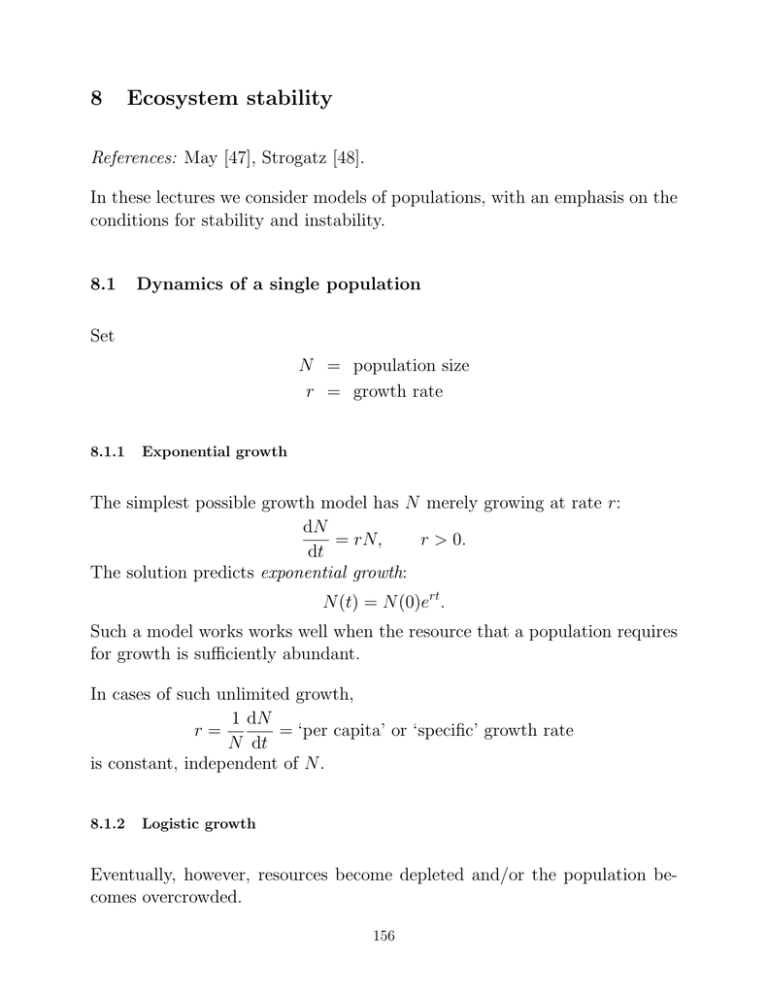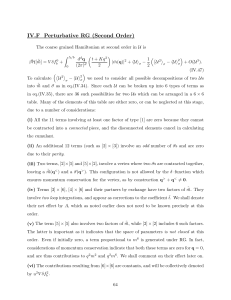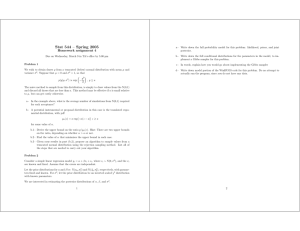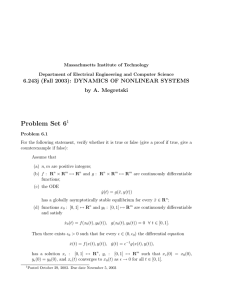Ecosystem stability 8
advertisement

8 Ecosystem stability References: May [47], Strogatz [48]. In these lectures we consider models of populations, with an emphasis on the conditions for stability and instability. 8.1 Dynamics of a single population Set N = population size r = growth rate 8.1.1 Exponential growth The simplest possible growth model has N merely growing at rate r: dN = rN, r > 0. dt The solution predicts exponential growth: N (t) = N (0)ert . Such a model works works well when the resource that a population requires for growth is sufficiently abundant. In cases of such unlimited growth, 1 dN r= = ‘per capita’ or ‘specific’ growth rate N dt is constant, independent of N . 8.1.2 Logistic growth Eventually, however, resources become depleted and/or the population be­ comes overcrowded. 156 Thus as N increases, we expect that r will decrease. Moreover it can even become negative, meaning that the death rate exceeds the birth rate. Graphically, we expect that r(N ) behaves like The point at which r(N ) = 0 is a special population size which neither grows nor decays. It corresponds to N = K, where K = carrying capacity. In most cases we can’t really know the shape of r(N ), but the notion of a carrying capacity is itself reasonably sharp. So the simplest assumption would be to assume that r(N ) decreases linearly: Then � � N r(N ) = r 1 − K and our growth model now reads � � dN N = rN 1 − , dt K (56) known as the logistic equation or the Verhulst model. The logistic equation can be solved exactly but our goals are better served by analyzing it qualitatively. First, we plot dN/dt vs. N , i.e., we plot the RHS of the logistic equation: 157 We consider only N ≥ 0 since populations cannot be negative. Note that Ṅ = 0, Ṅ > 0, Ṅ < 0, N = 0 or K 0<N <K N >K We call N = 0 and N = K fixed points because they correspond to neither growth nor decay. We denote them with asterisks: N1∗ = 0, N2∗ = K. Between N1∗ = 0 and N2∗ = K, N grows toward K; conversely, for N > K, N decays toward K. Thus we say that N1∗ = 0 is unstable and that N2∗ = K is stable. Indeed, we see that as long as we initiate growth with N (0) > 0 , the popu­ lation always evolves to the carrying capacity. How it evolves depends on the initial condition: • Small populations N < K grow exponentially and later slowly towards K, sometimes called S-shaped or sigmoid-shaped growth. • Large populations N > K decay exponentially to K. 158 Although specific details of the logistic model should not be considered as truly representative of population growth, the basic picture of exponential growth followed by saturation is widely but not universally observed. 8.1.3 Hyperbolic growth References: von Foerster et al. [49], Cohen [50], Johansen and Sornette [51]. One potential criticism of the logistic model concerns the notion of a fixed carrying capacity. For example, it is possible that, over long time scales, an organism can better dominate its niche as its population increases. It has also been proposed that species can create niches within which they, or new species that evolved from them, can thrive [52]. An outstanding example of a species with varying K is us: as our population has grown, technology has improved, allowing the population to grow even further. Thus we consider that K = K(N ). We then define the rescaled rate constant r� = r/K(0) so that the logistic equation now reads dN = r� N (K − N ). dt 159 For K = K(0) = const, this is merely a re-expression of equation (56). Now, however, we imagine that K increases with N like K ∼ N α, N � K(0). When α > 1, eventually K � N , and the growth equation is approximated by dN α > 1. ∼ N 1+α , dt Separating variables, we have dN = dt, N 1+α which upon integration yields −1 N −α = t + const. 1+α or N −α = (1 + α)(tc − t), where tc is a re-expression of the original integration constant. The solution is N (t) ∝ (tc − t)−1/α , t → tc , which exhibits a singular blow-up as t → tc , with tc determined by the initial conditions. Singular growth is sometimes called hyperbolic. Another mechanism for hyperbolic growth would be to consider the per capita growth rate r to grow with N , like r ∼ N β, β > 0. Such an expression assumes that growth is not limited by carrying capacity but instead reflects the ability of a population to find more efficient ways to reproduce (or ways to minimize its death rate). We then have dN = rN ∼ N 1+β , dt 160 and therefore, as above, N (t) ∝ (tc − t)−1/β corresponding to hyperbolic growth for β > 0 (whereas above we required α > 1). In 1960, von Foerster et al. [49] showed that world population for roughly the last millenium fit such a curve, with β � 1. This image has been removed due to copyright restrictions. Please see Figure 1. von Foerster, H., Mora, P. & Amiot, L. W. Doomsday:Friday, 13 November, A.D. 2026. Science 132(1960): 1291-1295. Since the fit provided an estimate of tc , von Foerster’s paper, published in Science, was titled Doomsday: Friday 13 November, A.D. 2026. The essential observation here is that human population growth has been super-exponential. Around 1970, however, the growth rate slowed. 8.2 Linear stability analysis We now return to the questions of stability we addressed in Section 8.1.2. 8.2.1 Single species We write our population model more generally as Ṅ = F [N (t)]. and interpret N as the number of individuals of a particular species. 161 Fixed points N ∗ are given by 0 = F (N ∗ ). To determine the behavior of the system near a fixed point, we consider small disturbances x(t) so that perturbed populations x(t) = N (t) − N ∗ . Differentiation both sides yields ẋ = N˙ . We therefore write ẋ = F (N ) = F (N ∗ + x) and we expand F around N ∗ : F (N ∗ + x) = F (N ∗ ) + xF � (N ∗ ) + O(x2 ). Noting that the LHS is simply ẋ and that F (N ∗ ) = 0, we have, neglecting terms of order x2 and higher, ẋ = xF � (N ∗ ). (57) Thus x grows if F � (N ∗ ) > 0, and x decays if F � (N ∗ ) < 0. The prediction of this linear stability analysis is either exponential growth away from a fixed point or exponential growth towards it. More specifically, we set a = F � (N ∗ ) and solve the linearization (57) to find that x evolves as x(t) = x(0)eat . Thus a < 0 ⇒ N ∗ is stable a > 0 ⇒ N ∗ is unstable Of course, the range of stability was already evident from our graphical anal­ ysis. 162 However we now also know the rate |a| at which the system grows away from, or decays toward, the fixed point. To apply this method to the logistic model (56), we note that � � ∗ 2N a = F � (N ∗ ) = r 1 − K Then a(N ∗ = 0) = r and a(N ∗ = K) = −r. The region of stability therefore depends on the sign of r. 8.2.2 Multiple species The stability of a multispecies model follows similarly. We imagine m species, each with an abundance Ni , i = 1, . . . , m, that evolves as Ṅi = Fi (N1 , N2 , . . . , Nm ), i = 1, . . . , m. The function Fi determines the growth rate of Ni as a function of its in­ teractions with other populations (and itself). p The fixed points Ni∗ are determined by setting the time derivative to zero: ∗ 0 = Fi (N1∗ , N2∗ , . . . , Nm ), i = 1, . . . , m. We expand around the fixed points: Ni (t) = Ni∗ + xi (t), i = 1, . . . , m. where xi (t) is a perturbation to the ith population. Neglecting terms of second order and higher in the perturbations, we obtain � m dxi � ∂Fi �� = xj i = 1, . . . , m. �� �∗ , dt ∂N j N =N j=1 163 To simplify, we define the Jacobian matrix A with elements � ∂Fi �� , i, j = 1, . . . , m. aij = ∂Nj � � � ∗ N =N In population ecology A is called the community matrix. We use it to rewrite the linearized dynamics compactly as d�x = A�x dt where �x is an m × 1 column vector of the xi ’s. (58) We seek solutions of the form �x(t) = eλt�v , where �v �= 0 and λ is a growth rate. Inserting into (58), we obtain λeλt�v = Aeλt�v or A�v = λ�v . (59) Therefore �v is an eigenvector of A and λ is an eigenvalue The eigenvalues and eigenvectors solve the characteristic equation det(A − λI) = 0, where I is the m × m identity matrix. Non-trival solutions occur when the determinant of A − λI vanishes. In other words, we find the eigenvectors λ by solving det(A − λI) = 0, and for each eigenvalue we then find the eigenvectors �v by solving (59). The general solution of (58) (assuming that all eigenvalues are distinct, and therefore that the eigenvectors are linearly independent) is then the linear combination �x(t) = c1 eλ1 t�v1 + c2 eλ2 t�v2 + . . . + cm eλm t�vm 164 where the ci ’s depend on the initial conditions. In general, the m eigenvalues are complex numbers λ = µ + iν that are solutions to an mth order polynomial. Stability is determined by the sign of largest µ: µmax < 0 ⇒ stable µmax = 0 ⇒ marginally stable µmax > 0 ⇒ unstable. A non-zero imaginary part ν corresponds to oscillations eiνt with frequency 2π/ν. 8.3 Predator-prey cycles: the Lotka-Volterra equations We now illustrate these principles with a simple two-component model of a predator and its prey: Ṅ1 = N1 (a − αN2 ) Ṅ2 = N2 (−b + βN1 ). In this system, known as the Lotka-Volterra equations, N1 N2 a b α, β = = = = = number of prey number of predators prey growth rate predator death rate rates of interaction between predators and prey a, b, α, and β are all positive. The fixed points occur where the derivatives vanish. We find one fixed point at N1∗ = b/β N2∗ = a/α 165 In the notation of the previous section, we have F1 (N1 , N2 ) = N1 (a − αN2 ) F2 (N1 , N2 ) = N2 (−b + βN1 ). The partial derivatives are ∂F1 /∂N1 ∂F1 /∂N2 ∂F2 /∂N1 ∂F2 /∂N2 a − αN2 −αN1 βN2 −b + βN1 . = = = = and the Jacobian matrix is then � � � ∂Fi �� 0 −αb/β A= = βa/α 0 ∂Nj �N1 ∗,N ∗ 2 The eigenvalues λ solve � � � −λ −αb/β � �=0 det �� βa/α −λ � which yields λ2 + ab = 0 and therefore λ = ±iω, √ ω = ab. Since Re(λ) = 0 , the fixed point is marginally stable. But the non-zero imaginary part means that perturbations to the fixed point are oscillatory, so that �x(t) = �c1 cos ωt + �c2 sin ωt where c1 and c2 are related to the initial conditions. In the phase space of x1 and x2 , linear stability analysis thus predicts that the perturbed trajectories are simply circles about the fixed point, the radius of which depends on the initial conditions. 166 Of course, larger amplitude trajectories depart from the circular shape due to nonlinear effects. The time functions x1 (t) are simple oscillations. Note, however, that the predator population N2 is delayed by a quarter-cycle (π/2) with respect to the prey population N1 . Specifically, we see that the growth rate of the predator is fastest when the prey population peaks, and conversely the predator death rate is fastest when the prey population bottoms out. Remarkably, just such a pattern is found in natural systems. The classic case is that of the 19th century Canadian lynx (predator) and snowshoe hare (prey) populations near Hudson Bay: Data from Ref. [53] 167 8.4 Stability vs. complexity These considerations raise a big question: What makes an ecosystem stable? We really don’t know, but empirically there is abundant evidence that the global ecosystem has changed greatly over long time scales. Number of marine animal genera As an example, note the Phanerozoic fossil record of biodiversity: 5000 4000 3000 2000 1000 0 -500 -400 -300 -200 -100 0 Time (106 years) Image by MIT OpenCourseWare. The causes of the fluctuations in this record are likely manifold, and are widely debated. One issue concerns the relative importance of intrinsic mechanisms of insta­ bility compared to extrinsic drivers such as impacts. We proceed to address the possibility of intrinsic instability within the context of the Lotka-Volterra model. One question that may be precisely answered is the following: How is stability related to diversity (i.e., complexity)?. To address this question, we return to the general formulation of Section 8.2.2, wherein each species potentially interacts with m − 1 others: Ṅi = Fi (N1 , N2 , . . . , Nm ), i = 1, . . . , m. From linear stability analysis, we found that perturbations from fixed points evolve like d�x = A�x, dt and that a fixed point is stable if, among the eigenvalues λ = µ + iν of A, we have µmax < 0. 168 We now focus entirely on the community matrix A. We require that each species be by itself stable, so that if perturbed individ­ ually from its fixed point it relaxes back to it. We take each time constant to be unity, so that aii = −1. Next, we allow interactions between species i and j via a matrix made of off-diagonal terms bij . As in the construction of a random graph or food web, we allow only only a fraction 0 < C < 1 of all possibile interactions, so that bij = 0 with probability 1 − C. The values of the non-zero bij give the strength and sign of the interaction between species i and j. We choose them randomly, with zero mean and variance s2 : � � with probability C : �bij � = 0 and b2ij = s2 . Assembling both pieces, the m × m community matrix A = B − I. A is stable only if each of its eigenvalues have negative real parts. Thus one would like to know, as a function of the the system size m, the connectance C, and the standard deviation s, the probability P (m, C, s) = probability of stability The May-Wigner stability theorem states [47, 54] P → 1 if s(mC)1/2 < 1 P → 0 if s(mC)1/2 > 1. Thus we have an answer to our question about the relation of stability to complexity. 169 Complexity can be interpreted in two ways: as the size m (i.e., diversity) of the ecosystem, or as its connectivity C. As either increases, the “equilibrium ecosystem” loses its stability. This conclusion is easily understood qualitatively. Since the eigenvalues λB of B satisfy B�x = λB �x and, by definition, I�x = �x, then, since A = B − I, A�x = (λB − 1)�x, i.e., the eigenvalues of A are given by λ = λB − 1. The essential statement, therefore, is that as B becomes large in dimension, as the fraction of its non-zero elements increases, and/or as the magnitude of its elements increase, eventually the real part of one of its eigenvalues exceeds unity, so that A becomes is unstable. 8.5 Discrete logistic model Unfinished—no more time. Come back next year! Return now to the logistic model (56) for a single population: � � dN N = rN 1 − . dt K Now imagine that we care only about the population changes from, say, year to year, and we take Nj to be the population in the jth year. Then the differential equation becomes the difference equation � � Nj Nj+1 − Nj = rNj 1 − K 170 or r 2 N . K j Now rescale the populations to the new variable Nj+1 = (1 + r)Nj − xj+1 = r/K Nj , 1+r which yields (1 + r)xj = (1 + r)2 xj − (1 + r)2 x2j . Setting 4µ = 1 + r we then obtain the discrete logistic equation xj+1 = 4µxj (1 − xj ). 8.5.1 Fixed points and stability 8.5.2 Period doubling 8.5.3 Chaos 171 MIT OpenCourseWare http://ocw.mit.edu 12.009J / 18.352J Theoretical Environmental Analysis Spring 2015 For information about citing these materials or our Terms of Use, visit: http://ocw.mit.edu/terms.





